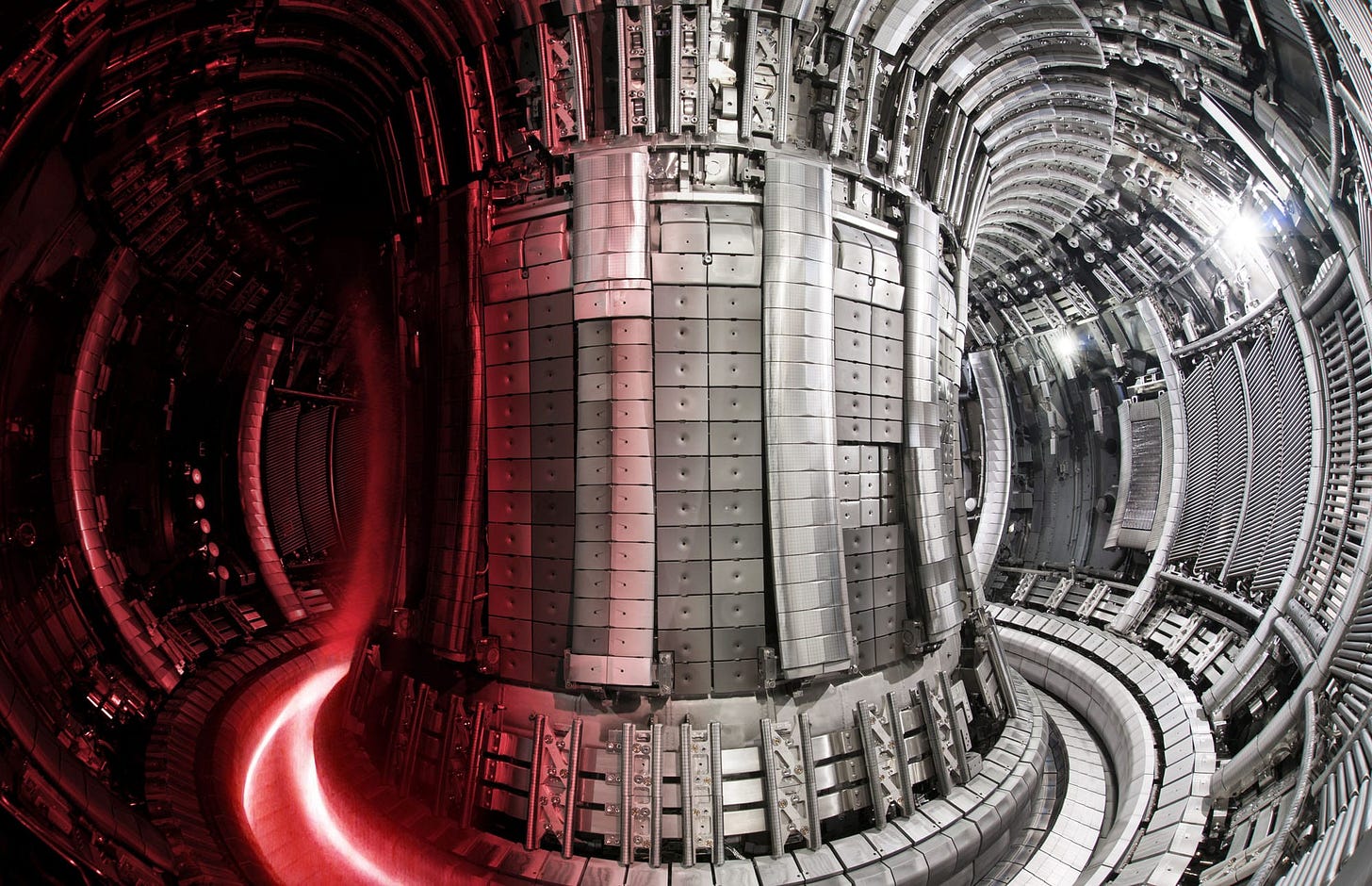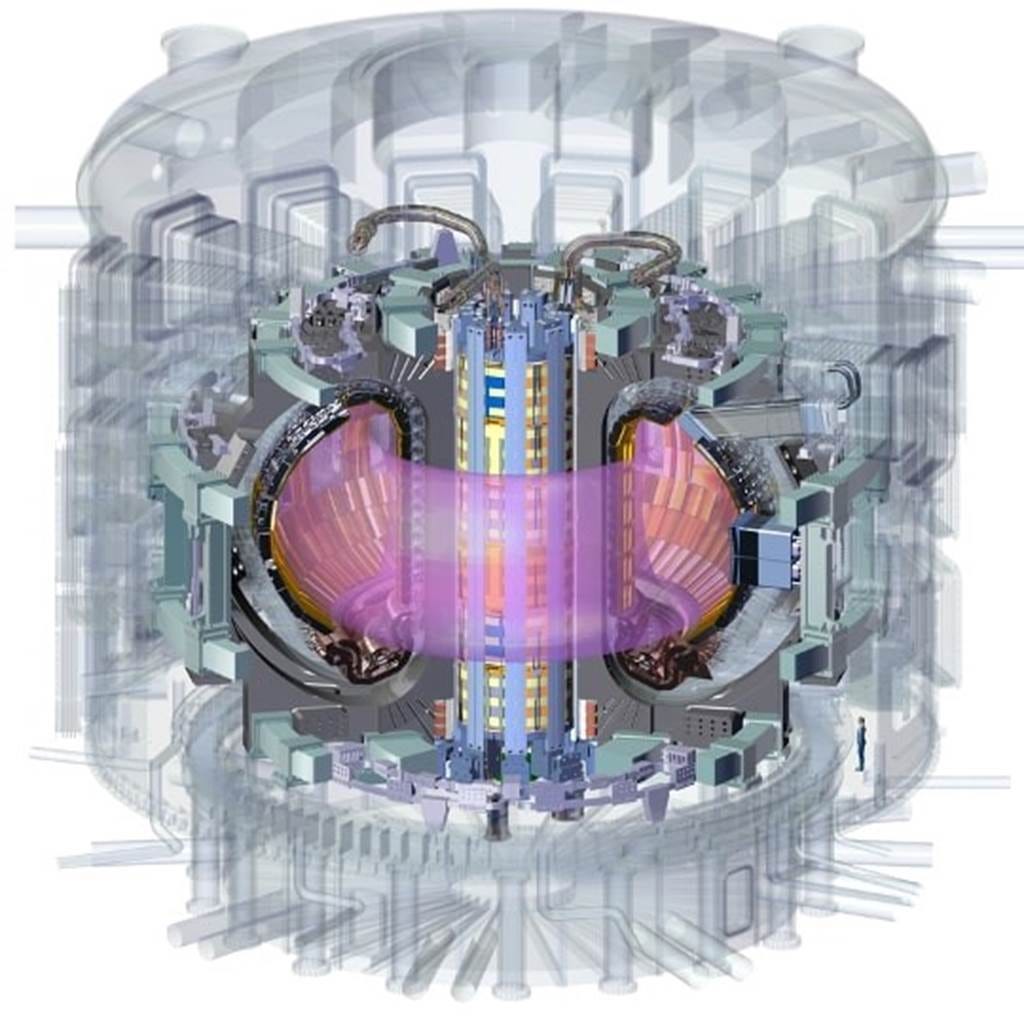All you need to know about the Spherical Tokamak
Bored of all future tech being "algorithms" and identikit smartphones? Well feast your eyes on fusion...
It’s 1969 in the Soviet Union. In the year that the Americans beat the Soviets to walk on the moon, a group of five British scientists were about to arrive in Moscow. What they observed there could change the course of human progress. Perhaps more than the moon landings themselves…
The British, known as the Culham Five, were there to test a Soviet claim. The USSR had built a machine that could create plasma at 10 million degrees Kelvin. The Soviets had presented results obtained in their T-3 Tokamak the previous summer. They claimed that the holy grail of energy production, fusion, the hearts of stars, was possible.
Inviting the British, in the middle of the cold war, to peer-review Soviet science, was a bold move. The British led in a temperature measurement technique known as laser scattering. If the Culham Five could confirm the Soviet’s results it would show technological advancement in orders of magnitude greater than any other fusion experiment before. After months of work, the British had the data they needed. The Tokamak design worked.
The interior of JET, (Joint European Torus). A now completed ‘magnetically confined plasma physics experiment’, located at Culham Centre for Fusion Energy in Oxfordshire, UK. Culham Centre for Fusion Energy
Nuclear, but not as we know it.
When we talk about nuclear energy, we usually mean fission. This, as the name suggests, is when atoms are split to release enormous amounts of energy. This produces heat that is used to drive steam turbines. The amount of energy you can get from a small amount of Uranium is colossal. Per kilowatt hour, fission power stations have the same carbon footprint as offshore wind farms. And they produce energy all the time.
This sort of nuclear power has some very well-known drawbacks. It produces a lot of dangerous radiation during production. It results in dangerous nuclear waste products, which must be specially processed and stored. And they can be used to produce the components for nuclear weapons.
Fusion, by contrast, is the combining of atoms together to produce energy. The fuel it uses is different - instead of plutonium or uranium, it uses hydrogen isotopes deuterium and tritium. These isotopes combine in a plasma releasing an even larger amount of energy. The plasma itself consists of a partially-ionized gas, containing ions, electrons, and neutral atoms. It occurs when a neutral gas gets hot enough and requires intense amounts of heat, pressure, and time to form and sustain.
So the job of the Tokamak is to recreate the environment for plasma to exist, to allow fusion to happen. A tall order as this is replicating millions of kilometers of star material and the gravity well in space to go with it.
The aim is to achieve something called the “Lawson criterion”. This is a figure of merit used in nuclear fusion research. It compares the rate of energy being generated by fusion reactions within the fusion fuel to the rate of energy losses to the environment. When the rate of production is higher than the rate of loss, the system will produce net energy.
Unlike fission, fusion is much safer. Fusion reactors can’t go into catastrophic meltdown like a fission plant. Additionally, they produce far less radioactive waste. And the waste they do produce is far less dangerous.
The Tokamak
тороидальная камера с магнитными катушками
toroidal'naya kamera s magnitnymi katushkami
Toroidal chamber with magnetic coils
So why don’t we all use fusion? The central issue with fusion power is this: when you manage to create the heart of a star here on Earth, it’s very hard to control. The Tokamak seeks to get around this by using powerful magnetic fields to confine plasma in the shape of a torus. (Doughnut shape). A Spherical Tokamak is the new millennium’s version of the original soviet design. Instead of a doughnut with a hole in the centre, think of an apple that has had its core removed.
There are two major barriers to this technology:
The first is that creating the heart of a star is extremely challenging. Maintaining the stability of the reactor for any length of time proving elusive. The colossal heat generates magnetic instabilities that in turn knocks the rector out. Being able to generate plasma constantly and reliably is the first step to being able to use Tokamaks for power generation. This in turn produces another challenge: the power used to run the magnates has to be considered in the Lawson criterion as well. This makes the barrier to net energy even higher.
The second problem is then using this energy to make electricity.
Capturing the energy
Once you’ve succeeded in producing plasma, (creating the environment for deuterium and tritium to fuse) the fusion produces one helium nucleus, one neutron, and terrific amounts of energy. The neutron has no electrical charge, but roughly 80% of the energy. As it has no charge it can get through the magnetic fields. Once through, it's absorbed by the walls (and specialist materials called 'blankets') of the Tokamak, where their kinetic energy is captured as heat. The Helium nucleus does have an electric charge, so remains inside the plasma. Meaning it contributes to the ongoing heating - very neat.
The concept is that the heat will be captured by cooling water circulating in the Tokamak walls. The heat will be used to produce steam and then, via turbines and alternators, electricity.
There are of course remaining challenges. More R&D is needed to unlock materials resistant to extreme conditions. Developments in robotics are needed to enable remote handling for maintenance. There are challenges around the tritium fuel cycle and efficiently capturing the electricity generation.
The prize is a system that can release nearly four million times more energy than a chemical reaction. (Such as the burning of coal, oil, or gas). And it could produce nearly four times more than nuclear fission, without many of the drawbacks.
So who are the players in this field?
There are over 70 Tokamak experiments active today, but the two organisations that caught my eye are below. One is a multinational lab experiment, in many ways far more impressive than the Large Hadron Collider but less well-known. The second is a private company looking to leapfrog the lab stage and go to net power with some very interesting IP.
The inside of a Tokamak. The pink represents the plasma, with the magnetic coils, power, and heat capture surrounding it. ITER
The International Thermonuclear Experimental Reactor, known as ITER, is a multinational collaboration based in the south of France. Aiming to build the world's largest tokamak, it was originally conceived in 1985 and includes China, the EU, India, Japan, Korea, Russia, Switzerland, the UK, and the US. Construction of the ITER complex in France started in 2013, and assembly of the tokamak began in 2020. The total price of construction and operations is projected to be from €18 to €22 billion. (for context the Large Hadron Collider cost €4.39 billion). A true example of collaboration, the ITER has been described as the most complex engineering project in human history. The ITER has 5 main goals:
1) Achieve a deuterium-tritium plasma in which the fusion conditions are sustained mostly by internal fusion heating. (This would effectively make it self-heating, a big step towards the Lawson criterion mentioned earlier.)
2) Generate 500 MW of fusion power in its plasma for long pulses. (This would mean 500 MW of fusion power from 50 MW of input heating power, a healthy 10x return).
3) Contribute to the demonstration of the integrated operation of technologies for a fusion power plant.
4) Test tritium breeding. (A cool concept where the incoming neutron is absorbed by a lithium atom, present in the heat blanket, which recombines into an atom of tritium and an atom of helium. The tritium can then be removed from the blanket and recycled into the plasma as fuel.)
5) Demonstrate the safety characteristics of a fusion device. (Sensible in my opinion).
As a huge science experiment, ITER is not expected to generate electricity. What it will do is break ground for commercial Tokamaks in the future.
Tokamak Energy’s ST40 Spherical Tokamak. Tokamak Energy
Tokamak Energy was founded in 2009 as a spin-off from the UK Atomic Energy Authority (UKAEA), which in turn has routes back to Culham Laboratories introduced at the beginning of this article.
Unlike ITER, Tokamak Energy is a private company. Their approach is to develop two technologies that offer the most efficient and commercially attractive route to fusion energy. They received funding from the UK and US governments (and have a US subsidiary as of 2019). Tokamak Energy also has significant private-sector investment.
Their two interesting intellectual properties are the Spherical Tokamak, a smaller (pocket-sized compared to the ITER!) and potentially more efficient, Tokamak design, and what they call the HTS Magnets.
HTS Magnets. Tokamak Energy
Standing for “High-Temperature Superconducting”, these magnets are a cool bit of tech that are more compact than other magnet technologies. They have Higher magnetic fields and improved performance, including Ultra-High Field (UHF) systems. (This is also useful for pretty much all communications technology). They have a higher temperature operation, important in the world of plasma, and are more cost-effective with reduced cooling costs and no need for liquid cryogens. Lastly, they have higher electrical efficiency. No electrical resistance means DC operation requires almost no electrical power.
The Spherical Tokamak is now in the advanced prototype design stage. The claim is that this prototype will have the potential to de-risk and accelerate the development of multiple technologies required for the delivery of sustainable fusion energy. This device is scheduled for build in the late 2020s.
The next stage will then be a fusion pilot plant. Hoping to deliver electricity into the grid in the 2030s, and paving the way for globally deployable 500-megawatt commercial plants.
Sometimes, we feel a bit disappointed about technological progress. Instead of hoverboards and Star-Ship Enterprise, we got TikTok and the Metaverse. Fusion technology is one of the reasons I remain a techno-optimist - it’s a fascinating bit of development, which if successful, could significantly combat climate change and improve our standards of living at the same time.








Indeed excellent article
Thank you for this insight. Am sharing it around.